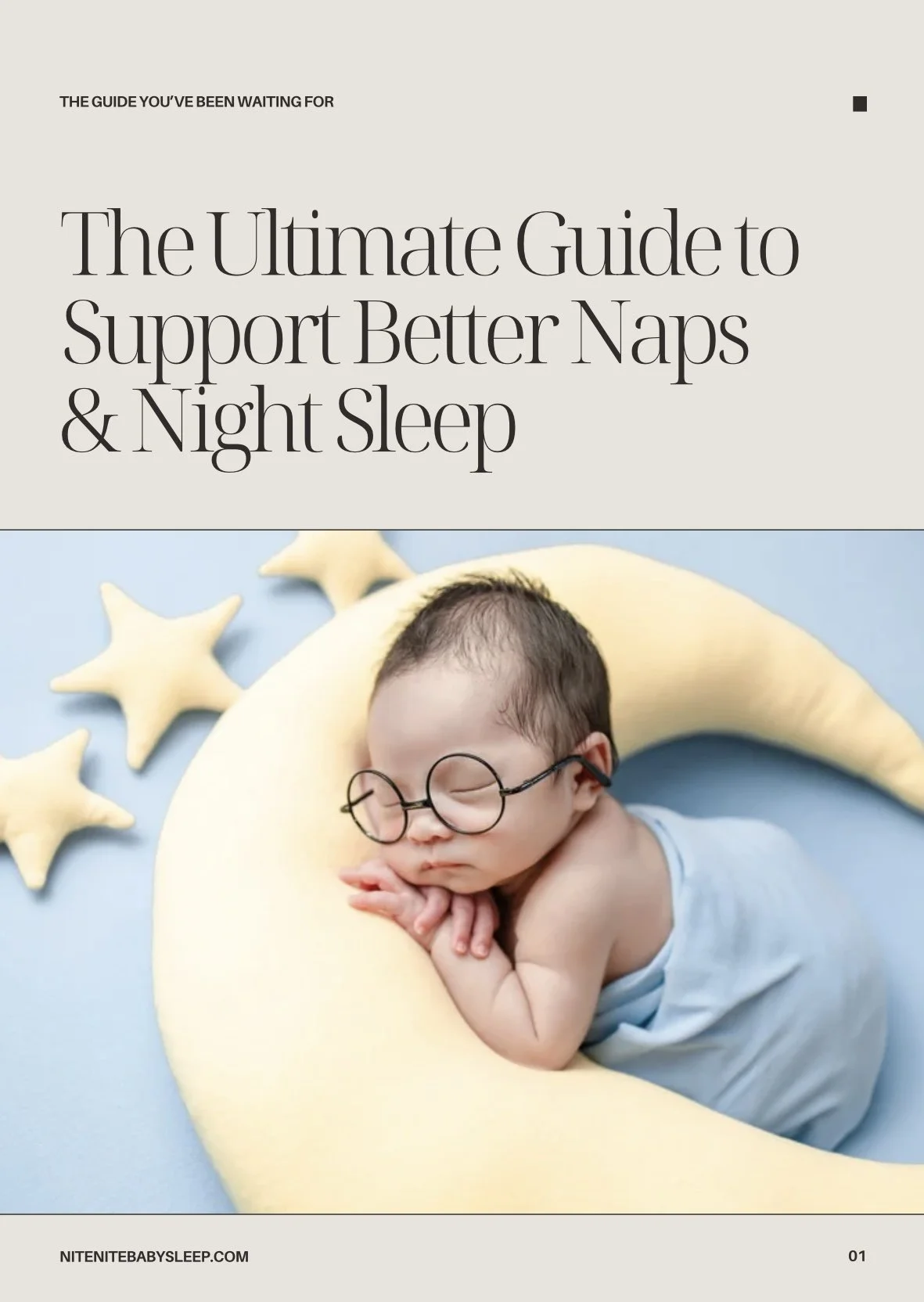The Ultimate Guide to Support Better Naps & Night Sleep: A Breakdown for Tired Parents
As a pediatric sleep consultant and founder of Nite Nite Baby, I created this free guide to be a supportive and approachable resource you can return to again and again. If you’re looking for a deeper dive into the guide before downloading—or just want a quick breakdown—you’re in the right place. Let’s walk through each page, with extra tips and science-backed insight to help your baby (and you!) get better rest.
Page 1: Welcome to the Ultimate Sleep Support Guide
This is the guide I wish I had as a first-time mom. It’s simple, digestible, and filled with tools to help parents confidently navigate naps and nighttime sleep. Whether you’re struggling with short naps, early wakings, or overtired evenings, this guide offers a solid foundation.
Think of this as your go-to manual for building healthy sleep habits without feeling overwhelmed.
💛 For Any Mama Who’s Struggling Right Now...
If you're reading this and feeling overwhelmed, exhausted, or just not like yourself—please know you are not alone.
Postpartum can feel incredibly heavy at times, even when you're surrounded by love. You’re not failing. You’re not broken. You’re a human navigating one of the biggest transitions life can bring.
Whether you’re battling the baby blues or quietly struggling with postpartum anxiety or depression, there is help—and hope. There are people who truly understand and want to support you, judgment-free.
Please take a moment to visit Postpartum Support International (PSI). They offer free helplines, text support, and local resources to walk alongside you.
You deserve to feel better.
You are doing the best you can.
And you are never, ever alone.
Page 2: How Sleep Changes Over Time
Babies’ sleep needs evolve quickly—especially in the first year. This page explains how and why those shifts happen. As your baby grows, the structure of their sleep naturally changes. From short, fragmented newborn sleep to more consolidated rest at night, understanding what’s “normal” at each stage can relieve so much stress.
Sleep Science Insight:
Circadian rhythms don’t mature until about 3–4 months, which is why sleep often feels unpredictable early on. Around that age, melatonin production increases and babies begin to consolidate sleep at night.
Pro Tip:
“A predictable day often leads to a more restful night.”
Creating rhythm through feeding, wake windows, and consistent nap routines helps babies learn what to expect—and feel secure.
Page 3: Helpful Tips to Know
This section is full of gold nuggets I often share with clients. A few favorites:
Sleep shifts rapidly in year one: Monthly at first, then stabilizing.
Consistency beats perfection. Focus on rhythm over a strict clock.
Prioritize night sleep. Around 11 hours is ideal, but always adjust based on total sleep needs.
Cap naps at about 2 hours to protect overnight sleep quality.
Sleep transitions take time. Whether dropping a nap or adjusting bedtime, expect some turbulence for 1–3 weeks.
Wake windows are guides, not rules. Use your baby’s cues too.
Independent sleep skills matter most. A perfect schedule doesn’t help if a baby still needs your help every time they wake.
Extra Tip:
If you’re seeing nap resistance, it’s often due to under tiredness or overtiredness. Try adjusting wake time in 15-minute increments to see if it helps.
Page 4: How Much Sleep Does My Baby Really Need?
Here’s the ultimate cheat sheet: a sleep chart breaking down average sleep needs by age. I often refer to this when creating personalized sleep plans.
The chart covers:
Total sleep by age
Typical nap patterns
Max nap lengths
Wake windows
Nighttime sleep averages
Safe limits for daily nap totals
Why it matters:
This gives realistic expectations and prevents common issues like under tiredness at bedtime or chronic overtiredness from too little sleep.
Coming Soon:
Want help with nap transitions? Keep an eye out for these upcoming blog posts:
Tips for Transitioning from 2 to 1 Nap
Once published, this blog will link directly to them for easy access.
Page 5: Need Personalized Sleep Help?
Sometimes the guide isn’t enough—and that’s okay! This page is your invitation to get personalized help from me.
Here’s what I offer:
An open Q&A space for any sleep question—no strings attached
Whether you’re just beginning your sleep journey or stuck at a specific stage, I’m here to support you with science-backed strategies and compassion.
Wrapping Up: Better Sleep Starts Here
Parenting is hard—but sleep doesn’t have to be a mystery. I created this guide to be a starting point, not a rulebook. Every child is unique, and your journey will be too.
If this guide helped, I’d love for you to explore more of my blog. Coming soon:
Signs Your Baby is Ready to Drop a Nap
You can also follow me on 📌 Pinterest for daily parenting and sleep support!
Until then—wishing you and your little one restful nights and peaceful naps.
Kenyon | Founder, Nite Nite Baby








